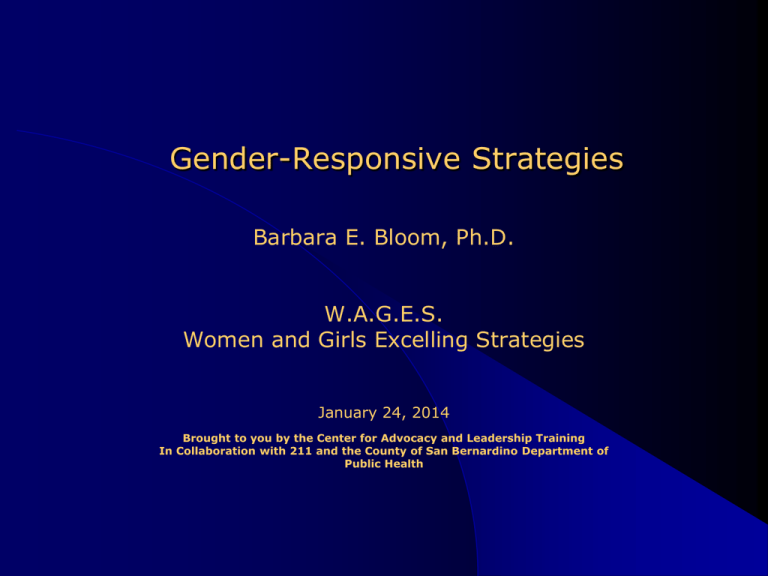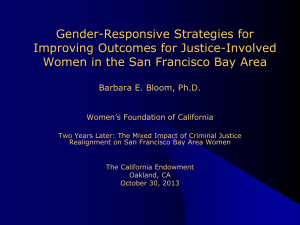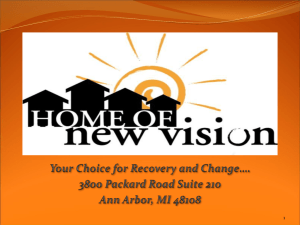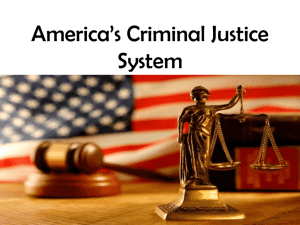B. Bloom Cambridge Presentation
advertisement

Gender-Responsive Strategies Barbara E. Bloom, Ph.D. W.A.G.E.S. Women and Girls Excelling Strategies January 24, 2014 Brought to you by the Center for Advocacy and Leadership Training In Collaboration with 211 and the County of San Bernardino Department of Public Health Overview The goals of this training are to provide the following: Profile of justice-involved women; Overview of gender-responsive principles and strategies; Information and research on genderresponsive programs and services; and Implications and examples for policy and practice Women and Girls in the CJ System Compared with men, women – Have more severe histories of sexual/physical abuse Have a higher prevalence of mental and physical health problems, including trauma related to abuse Have patterns of drug abuse that are more socially embedded – revolving around their interpersonal relationships Are typically primary caregivers for minor children Have limited education and employment histories Respond differently to treatment and correctional supervision Justice-Involved Women Over 1 million women are under criminal justice supervision in the U.S. The majority are supervised in the community on probation or parole. Imprisoned Women – U.S. There were over 111,000 women incarcerated in U.S. state and federal prisons in 2011 (6.7% of the overall prison population). The number of women in prison increased at nearly 1.5 times the rate of men (637% versus 419%) from 1980 to 2011. Women of color made up about 43% of state and federal prison populations. African American women were imprisoned at 2.5 times the rate of white women and Latinas were imprisoned at 1.4 times the rate of white women. Source: BJS, Prisoners in 2011, December 2012 Women in U.S. Jails In 2011, there were 93,300 women in local jails (12.7% of the overall jail population), up from 92,368 (12.3%) in 2010. Approximately 60% of the jail population was unconvicted and awaiting court action. The greatest increase in the female jail population was in California. Source: BJS, Jail Inmates at Midyear 2012 Women on Probation & Parole In 2011, there were over 712,000 women on probation and over 103,000 on parole in the U.S. This represents approximately 81% of the women under criminal justice supervision. San Bernardino County Average Daily Jail Population-8/11/13 = 5928 Male 87.6% Female 12.4% White Black Hispanic Other 29.8% 20.5% 46.5% 2. 5% Non-sentenced = 62% Sentenced = 37% Source: San Bernardino Co. Sheriff, Aug. 15, 2013 Gender Differential in Offense Patterns Female crime rates usually much lower than male rates Women’s crimes are predominantly: • • • • Petty theft Low-level drug use & sales Minor fraud Prostitution The gender gap is greatest for serious crime & least for less serious types of crime In 2011, women were more likely to be in state prison for drug and property offenses (63%) versus violent offenses (37%) while men were more likely to be in prison for violent offenses (54%) versus drug and property offenses (46%). Source: BJS Prisoners in 2011 (2012) Imprisoned Women - CA In 2011, there were 9,038 women in California state prisons, down from 9,763 in 2010. The number dropped to 5,919 on June 30, 2013. Post-realignment, new prison admissions of women declined by 60%. Sources: CDCR, May 2013; CJCJ, March 2013 Seven Major Counties Reduced Commitments to State Prison by 50% Santa Barbara Santa Clara Kings Tulare San Mateo Ventura San Bernardino Gender Matters Based upon the significant growth in women’s and girls’ involvement in the criminal justice system, it is important for policy makers and practitioners to acknowledge the appropriate role of gender in the criminal justice system. Gender matters significantly in shaping patterns of offending as well as the criminal justice system’s response to criminal offending. Gender is also important in examining the differential effects of current policies and practices. Current sentencing laws are based on male characteristics and male crime and fail to take into account the reality of women’s lives, characteristics, responsibilities, and roles in crime. What Does Gender Responsive Mean? Gender responsive means creating an environment through site selection, staff selection, program development, content and material that reflects an understanding of the realities of women’s and girls’ lives and addresses their challenges and strengths. (Covington & Bloom, 2002) Differences with a Distinction: Women and Correctional Practice Correctional institutions are managed based on policies and procedures developed for the management of male prisoners. Gendered differences in women’s pathways to imprisonment, offense patterns, behavior while incarcerated and their needs before, during, and after incarceration must be considered in planning appropriate correctional policies and programs. Criminal Justice Practices There is a need to develop genderresponsive programming for women and girls that is based on their life circumstances and pathways to crime. Criminal justice practices that impact women such as bail, sentencing, classification, management strategies, and transition to the community have gendered implications. Making the Case for Appropriate Policy & Practice for Criminal Justice Involved Women Gender responsiveness is key to meeting the goals of the criminal justice system by: Acknowledging differences between men & women Targeting pathways to offending Developing policy & practice Five Key Findings . . . 1. An effective system for females is structured differently than for males 2. Gender-responsive policy & practice targets women’s pathways to criminality by providing effective interventions that address four central issues: substance abuse, trauma, mental health, & economic marginality 3. Correctional sanctions & interventions consider the lesser degree of harm created by the typical offense patterns of women 4. Gender-responsive policy & practice considers women’s relationships (especially family) & their roles in the community when delivering both sanctions & interventions 5. Community services are essential to a gender-responsive CJ system Mental Illness Substance Abuse Other Health Problems HIV/ AIDS Trauma Homelessness © S. Covington, 2012 Source: Vivian Brown, Ph.D. Family Background Likely to come from a single-parent home Almost 17% lived in foster care or in a group home More likely than men to have at least one family member that has been incarcerated Substance Abuse Approximately 80% of women in state prisons have substance abuse problems About half had been using alcohol, drugs, or both at the time of their offense Nearly 1 in 3 women in state prisons report committing the offense to support a drug habit Women in state prisons report higher drug usage than their male counterparts Violence Against Women • Women in the CJ system have extensive histories of physical & sexual abuse and are 3 times more likely than men to have a history of abuse • One-third of women in state prison & onequarter of those in jails report being raped at some time in their lives • Women’s substance abuse is highly correlated with physical & sexual abuse Health Issues • Males & females experience disease differently (cardiovascular disease, cancer, sexually transmitted diseases, HIV/AIDS) • Women prisoners have backgrounds of inadequate health care & risky behaviors • Women prisoners are more likely than men to test positive for HIV • Pregnancy & reproductive needs Mental Health Women in the criminal justice system have a higher incidence of mental disorders than women in general Women in the criminal justice system have histories of abuse associated with psychological trauma Approximately 75% with serious mental illness also have co-occurring substance abuse disorders Women with mental illness & co-occurring disorders experience difficulties in prisons and jails Substance Abuse, Mental Health and Trauma • The interrelationship of substance abuse, mental health & trauma is different in the lives of women • 82% of women in jail had a lifetime substance use disorder • 53% had Post Traumatic Stress Disorder (PTSD) in their lifetime • 43% had a serious mental illness, such as depression, bipolar disorder or schizophrenia • Source: Lynch, S., DeHart, D., Belknap, J. & Green, B. (2012). Pathways Project Trauma History Among Criminal Justice-involved Women Women in the criminal justice system have much higher rates of childhood and adult trauma exposure than women in the general population Trauma history is associated with alcohol and drug dependence, high-risk behaviors, sex work, and physical and mental health disorders among women in criminal justice settings © S. Covington, Ph.D., 2012 Children • Approximately 70% of women under correctional supervision have at least 1 child under 18 • Two-thirds of incarcerated women have children under 18 • An estimated 1.3 million minor children have a mother under correctional supervision • More than a quarter of a million children have mothers in jail or prison Education & Employment An estimated 55% of women in jail, 56% in state prisons & 73% in federal prisons have a high school degree Approximately 40% of women in state prisons were employed at the time of arrest compared to 60% of males 37% of women compared to 28% of men had incomes of less than $600 per month prior to arrest Reentry Challenges Reunification with Children Employment Housing Medical and Mental Health Services Childcare Support Systems Legal Barriers Facing Women Returning to Their Communities Personal Responsibility & Work Opportunity Act of 1996 Temporary Assistance for Needy Families (TANF) Higher Education Act of 1998 Public Housing - Section 8 Adoption and Safe Families Act of 1997 Discrimination Principle 1 Acknowledge that gender makes a difference Principle 2 Create an environment based on safety, respect, & dignity Principle 3 Develop policies, practices & programs that are relational & promote healthy connections to children, family, significant others, & the community Principle 4 Address substance abuse, trauma, & mental health issues through comprehensive, integrated, culturally relevant services & appropriate supervision Principle 5 Provide women with opportunities to improve their socioeconomic conditions Principle 6 Establish a system of community supervision & reentry with comprehensive, collaborative services Effects of Gender on Current CJ Practice Classification & assessment procedures Women’s services & programs Staffing & training Risk/Needs Assessment Influenced by two theoretical perspectives: 1. The Canadian Model – gender-neutral (Andrews, Bonta, Gendreau, Hoge) 2. Feminist/Gender Responsive Model (Bloom, Owen, Covington, Chesney-Lind) Canadian Model “The Big Four” Criminal Criminal Criminal Criminal history associates personality thinking Stand-Alone Women’s Risk/Needs Assessment Criminal history Criminal thinking (sample variations) Antisocial associates Vocational/educational Financial problems Low family support Housing problems Substance abuse Mental health history Depression/anxiety (symptoms) Psychosis/suicidal (symptoms) Victimization/trauma Relationship dysfunction Parental stress Housing safety And strengths (self-efficacy, family support, parental involvement, and educational assets) (National Resource Center on Justice Involved Women) The Foundation for Women’s Services Safety • Community • Institutional Rehabilitation • Programming • Treatment • Services Approaches for Developing Gender-Responsive Programs and Services Structure • Contemporary theoretical perspectives on women’s (and girls) particular pathways into the criminal justice system (e.g., relational theory, trauma theory) fit the psychological and social needs of women and reflect the realities of their lives. • Treatment and services are based on women’s (and girls) competencies and strengths and promote self-reliance. Structure (cont.) • • • Women-only groups are used, especially for primary treatment (e.g., trauma, substance abuse) Staff members reflect the client population in terms of gender, race/ethnicity, sexual orientation, language (bilingual), and exoffender and recovery status. Female role models and mentors are provided who reflect the racial, ethnic, and cultural backgrounds of the clients. Approaches for Developing Gender-Responsive Programs and Services Content and Context/Environment • • To fully address the needs of women, programs use a variety of interventions with behavioral, cognitive, affective/dynamic, and systems perspectives. Services/treatment address women’s practical needs, such as housing, transportation, childcare, and vocational training and job placement. Content/Context/Environment • • • Participants receive opportunities to develop skills in a range of educational and vocational (including nontraditional) areas. Emphasis is placed on parenting education, child development, and relationship/reunification with children. The environment is child friendly, with age-appropriate activities designed for children. Services and Programs for Women Should Acknowledge Gender Issues • Substance abuse • Physical, sexual, and psychological abuse • Health and mental health • Education & vocational training • Life skills Staffing and Training • Recruit staff who have both the interest and knowledge, ability and skill to work with women under criminal justice supervision • Provide training in gender-responsive and trauma-informed practice • Cross-train staff in substance abuse and mental health treatment The Context of Women’s Lives: A Multidisciplinary Review of Research & Theory Theoretical Perspectives • Pathways Perspective • Relational Theory & Female Development • Trauma Theory • Addiction Theory Pathways Perspective • Women’s crimes embedded in the conditions of their lives • Examines the specific life course events that place women at risk for offending • Triple jeopardy: The impact of race, class & gender (Bloom) • Multiple marginality: From families, school, work (Owen) • Trauma & addiction (Covington) The Relational Context is Critical in Understanding: • Reasons why females commit crimes • Behavior under supervision • Motivation for change • Reintegration into the community • Relationships with children & significant others Trauma Theory • Trauma is the injury done by violence & abuse • Trauma occurs on multiple levels • Trauma recovery (Herman) • Trauma-informed services Trauma-informed Services • Take the trauma into account. • Avoid triggering trauma reactions and/or traumatizing the individual. • Adjust the behavior of counselors, other staff and the organization to support the individual’s coping capacity. • Allow survivors to manage their trauma symptoms successfully so that they are able to access, retain and benefit from the services. (Harris & Fallot) A Culture Shift: The Core Values of Trauma-Informed Care • Safety: Ensuring physical and emotional safety • Trustworthiness: Maximizing trustworthiness, making tasks clear, and maintaining appropriate boundaries • Choice: Prioritizing woman’s choice and control • Collaboration: Maximizing collaboration and sharing of power with woman • Empowerment: Prioritizing empowerment and skill-building Theory of Addiction • Holistic health model • Relational aspects of addiction • Incorporation of trauma & relational theories Emerging Research and Best Practices • Use evidence-based and gender-responsive research to inform the development of tools and interventions • Target women’s specific risk factors • Create environments that are safe, supportive, and respectful • Assure that interventions are traumainformed Emerging Research and Best Practices • Acknowledge how relationships affect women’s lives • Develop coordinated case management that is strength-based, trauma-informed, relational, and culturally competent • Build partnerships with a range of community organizations (public and private) to establish gender and culturally responsive multidimensional, wraparound services The Evidence: Women-Centered Materials and Programs That Show Improved Outcomes Helping Women Recover (Covington) Beyond Trauma (Covington) Seeking Safety (Najavits) Female Offender Treatment and Employment Program (FOTEP - CA) In-Prison Substance Abuse Program (S. Covington’s curriculum) Women Offender Case Management Model (NIC) Moving On (Vandieten & MacKenna) Treatment Components Associated with Better Outcomes for Women Review of 38 studies with randomized and nonrandomized comparison group designs: Child care Prenatal care Women-only admissions Supplemental services and workshops on women’s focused topics Mental health services Intensive case management Comprehensive programming City and County of San Francisco Women’s Community Justice Reform Blueprint Integrate criminal justice and community services and programs through a collaborative leadership structure. Develop sentencing and pretrial alternatives by expanding noncustodial and community alternatives. Create an intensive and coordinated case management system that follows women through every phase of the criminal justice process. Expand and enhance programming that creates a continuum across custodial, residential and non-residential settings. Design an integrated data collection, evaluation and oversight process to monitor, inform and improve systems. What is the Work? • Prevention • Do no harm • Gender-responsive services • Reentry to community Source: Covington, S. and Bloom, B., 1999 Conclusion • Gender matters • Integration of gender-informed theories will increase the efficacy of services for women and girls. • Consideration of women’s (and girls) pathways into the criminal justice system is critical to assessment and case management. • Women’s (and girls) strengths should be incorporated into any model of rehabilitation. • Multi-disciplinary approaches will yield the greatest results for women and girls. “…women whose lives represent all women’s issues-magnified.” Resources Center for Gender and Justice centerforgenderandjustice.org National Institute of Corrections nicic.gov Barbara Bloom bloom@sonoma.edu








